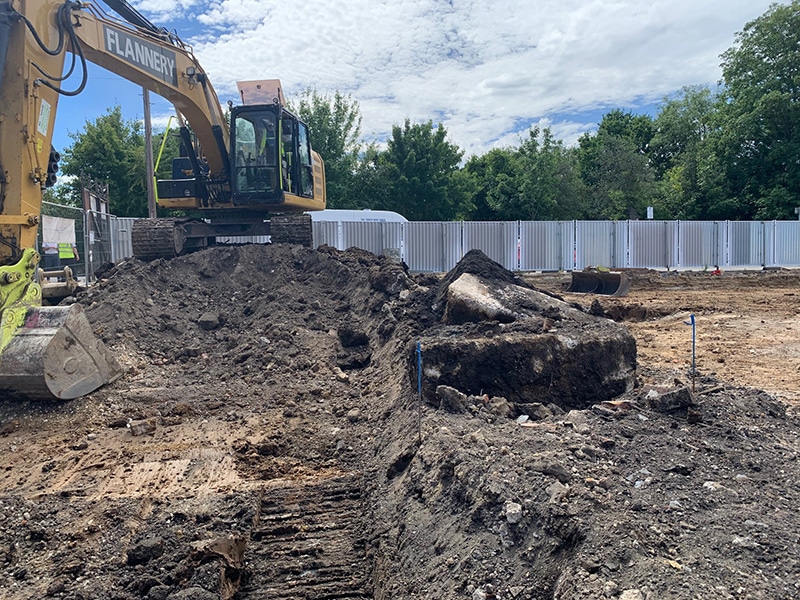How Can I Dispose of Asbestos in Soil?
Asbestos is a carcinogenic material made up of flexible fibres. It’s naturally resistant to electricity and heat. That once made it a popular item in building materials. Eventually, asbestos’ hazardous properties became known. When inhaled, asbestos fibres can stick to the lungs. This can cause life-threatening diseases decades down the road.
Today, asbestos is no longer used in construction. Because of its once-widespread use, though, asbestos is still commonly found across the United Kingdom.
Soil becomes contaminated with asbestos when ACMs mix in with it. Like all forms of asbestos, contaminated soil must be disposed of properly. Otherwise, workers and people in the area can be at risk of inhaling airborne fibres.

Sources of asbestos contamination in soil
Sometimes, ACMs make their way into soil. This contaminates the land. The specific type of ACM will depend on the land use history and any known or suspected sources of asbestos contamination.
Here are some common types of ACMs found in soil:
- Building materials: Asbestos was commonly used in building materials. That includes cement pipes, floor tiles, insulation, and roofing tiles. These materials can break down over time. When that happens, asbestos fibres release into the soil.
- Industrial waste: It’s possible that waste from industrial processes contains asbestos. This may include waste from manufacturing facilities, mining operations, or power plants.
- Landfill waste: Asbestos-containing waste is sometimes disposed of in landfills. It can then contaminate the surrounding soil.
- Natural deposits: Asbestos is a naturally occurring minimal. Because of that, deposits of rocks or soils that contain asbestos can contaminate the surrounding land.
Locations of contaminated soil
Asbestos-contaminated soil can be in many locations. Those include the following:
- Construction sites: ACMs were commonly used in construction projects. Contaminated soil may be near sites where older buildings are being demolished or renovated.
- Former industrial sites: Asbestos was commonly used in industrial processes and products. Contaminated soil may be near old factories, power plants, refineries, and other industrial sites.
- Landfills: Asbestos-containing waste is sometimes disposed of in landfills. In this case, soil near the landfill may be contaminated.
- Natural deposits: Since asbestos occurs naturally, deposits of it can sometimes be in rocks or soil. When this happens, the land is considered contaminated.
- Residential areas: In the past, ACMs were commonly used in residential buildings. It’s possible that contaminated soil is present near older apartment buildings or houses.
Health risks associated with asbestos-contaminated soil
Today, the health risks of asbestos are widely known. When asbestos fibres become airborne and are inhaled, they can adhere to the lungs. This can cause serious and fatal conditions 10 or more years in the future, including asbestos-related cancers.
However, for our purposes, the question is: Does contaminated land pose the same risk as other types of asbestos?
As we state in our Guide to Working With Asbestos Contaminated Land, Soil, and Construction Waste, “As asbestos on or in contaminated land and soil are more likely to be damaged, fragmented, and fibrous, the risks are greater.”
Damaged ACMs have a higher chance of releasing fibres, and damage is more likely in contaminated soil than in ACMs that are still in structures. In other words, ACMs in buildings have a higher likelihood of being in better condition than ACMs in soil, limiting asbestos exposure.
Also, some contaminated land is never identified as containing asbestos. When excavation and other types of work occur, ACMs become more damaged, releasing more fibres. This poses a high risk to workers and visitors in the area.
How to identify asbestos in soil
It’s important to determine the type of ACM that’s contaminating the soil. Doing this will help determine how to remove the asbestos. According to CL:AIRE, it will also “estimate the potential fibre release for assessment purposes.”
Methods for identifying asbestos in soil
Identifying the type of ACM that’s contaminating soil is difficult unless the ACMs are large and easily observed. Here are a few guidelines laid out by CL:AIRE:
- When possible, asbestos cement should be distinguished from asbestos insulating board (AIB). Laboratory analysis may be required for this, but it’s not always effective.
- When possible, asbestos coatings should be distinguished from asbestos insulation.
- It may be too difficult to determine what type of asbestos is contaminating the soil. In this case, decide if it’s fibrous board/sheeting debris or loose fibrous debris.
Identifying the ACM isn’t the only consideration. It’s also important to identify the type of fibres present in the soil. This will help determine how likely it is that the fibres will become airborne.
When to seek professional help with identification
Unless you have experience or training when it comes to identifying asbestos, it’s best to contact a professional. They can conduct a land survey for you. This will detail which ACMs are on-site, how much asbestos contamination there is, and the likelihood of distribution.
Regulations and guidelines for asbestos disposal
According to the Health and Safety Executive (HSE), asbestos waste is hazardous and must be disposed of accordingly. This includes following guidelines such as:
- ACMs should not be broken up into smaller pieces for disposal.
- Waste must be carefully bagged and labeled as hazardous.
- The asbestos waste must be transported by somebody with the proper licence.
- You can only dispose of asbestos waste at a licenced site.
Here are the two main types of licences required for working with asbestos:
- Standard Asbestos Licence: This type of licence is required for work involving friable asbestos, such as pipe insulation. It’s issued by the Health and Safety Executive (HSE).
- Asbestos Removal Contractor Licence: This type of licence is required for work involving non-friable asbestos, such as asbestos cement. It’s also issued by the HSE.
Consequences of improper asbestos disposal
If you disregard the guidelines for properly disposing of asbestos, you may face a fine or imprisonment. The prison sentence can be as long as two years. You’ll also be putting workers and others at risk for developing major health problems.
Can you dispose of asbestos yourself or do you need a professional?
If you have a large amount of asbestos-containing soil to dispose of, it’s best to hire a licenced asbestos-removal contractor. You want someone who has experience handling and disposing of ACMs.
However, regardless of how much asbestos-containing soil there is, it’s your legal responsibility to have it removed. Failing to comply with the guidelines can result in fines or other types of legal action. There’s no safe amount of contaminated soil. It’s always best to speak with a professional unless you’re 100% sure of how to safely handle and dispose of it.
How do you safely dispose of asbestos in soil?
Here’s a brief overview of how to safely dispose of asbestos-contaminated soil:
- Identify the type of ACM in the soil. You’ll need to have an accredited organisation survey and test the soil.
- Make preparations for asbestos removal. For example, ensure that you have the appropriate equipment. That includes personal protective equipment (PPE) and respiratory protective equipment (RPE).
- Wet the soil. This can help minimise the number of asbestos fibres released into the air during the removal.
- Remove the ACM. The ACM should be carefully removed from the soil using hand tools like shovels or trowels. Do not use power tools. They can break the ACMs up more and generate dust. That increases the risk of exposure to asbestos.
- Package and label the ACM. Double-bag the ACM in heavy-duty plastic bags. Then seal the bags and label them as asbestos waste. It’s important that the bags are strong enough to not tear during transport.
- Transport the asbestos waste. The waste should be transported to a licenced disposal site by a licenced waste carrier.
- Decontaminate your equipment. Once the ACM has been removed from the soil, any equipment used should be decontaminated or disposed of. If disposing of the equipment, it needs to be treated as asbestos waste.
- Confirm that all asbestos has been removed. This requires testing, sampling, and analysis by a United Kingdom Accreditation Service (UKAS) body.
Note that safely disposing of asbestos-contaminated soil is a highly regulated process. It should only be undertaken by competent, trained contractors, like those with an asbestos licence.
Additionally, the process above is for bulk asbestos contamination. It’s not suitable for fibrous asbestos contamination. Depending on your specific situation, additional or different measures may be necessary.
Final Thoughts About Disposing of Asbestos-Contaminated Soil
Proper asbestos disposal keeps everyone in the vicinity safe from inhaling dangerous asbestos fibres. Whether it’s a worker carrying out a job on the land or a passerby out for a walk, ensuring that contaminated soil is disposed of means keeping yourself and others safe.
There are strict guidelines about how to dispose of asbestos. Following these rules means limiting the risk of an exposure event and preventing one in the future.
If you’re a duty holder, familiarise yourself with the ins and outs of asbestos disposal. It’s also wise to hire a professional who can guide you through each step of the process.

Written by Mark Carter
Mark Carter is a renowned expert in asbestos management, offering clients vital guidance on compliance and safety. His expertise is invaluable for navigating asbestos regulations, ensuring both safety and legal adherence. Mark's role is central in providing effective asbestos-related solutions, helping clients achieve their business objectives with an emphasis on regulatory compliance and safety in asbestos management.
